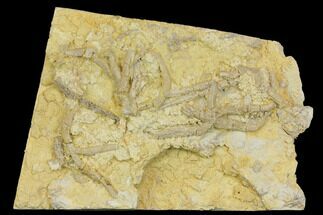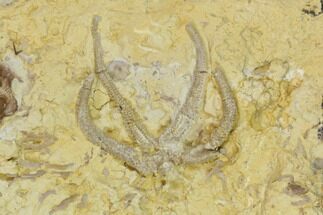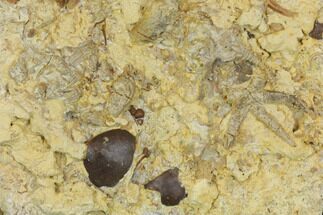This Specimen has been sold.
Large, 6.1" Fossil Brittle Star w/ Carpoids & Edrioasteroids - Morocco
This is a fascinating, 29" long slab of rock containing a large, 6.1 wide fossil brittle star (Ophiura sp.) associated with a number of relatively large carpoids and a couple edrioasteroids, collected from the Kataoua Formation of Morocco. It is Ordovician in age, approximately 450 million years old. The detailed preservation of all the fossils is exceptional!
It comes with a metal display stand.
The plate was collected in multiple pieces, requiring some crack repair and gap fill restoration within a couple of the cracks.
It comes with a metal display stand.
The plate was collected in multiple pieces, requiring some crack repair and gap fill restoration within a couple of the cracks.
About Carpoids
Carpoids are enigmatic organisms. They are early echinoderms related to starfish and sea urchins. Unlike modern echinoderms, carpoids lack the five fold radial symmetry and water vascular system. Most were asymmetrical or bilaterally symmetrical. But like other echinoderms, they did possess a skeleton of calcite plates. Depending on the species, carpoids had one or two ambulacra (filtering appendages), a theca (“head”) and a three-section stele (“tail”). They are likely early ancestors of starfish and other echinoderms, but they may also be an early ancestor of Chordates, the phylum that humans belong to. This is a contentious theory, based on the presence or absence of early gills in carpoids. Because these organisms are only known from fossils, gills are hard to identify accurately.
Carpoids evolved during the Middle Cambrian Period and disappeared from the fossil record during the early Devonian Period.
Carpoids were unconventional-looking organisms. Their vital organs were contained in a theca, and internal organs were surrounded by calcite plates. Depending on the species of carpoid, one or two ambulacrum extended from one end of the theca. These were appendages for filtering water for food. A mouth was located at the base of the ambulacrum if there was just one, or between them if there were two. From the other end of the theca, the three section stele (“tail”) extended. This was used either for locomotion or to hold the organism in place if fixed in one location. Carpoids grew up to about 4 inches (10cm).
Carpoids are enigmatic organisms. They are early echinoderms related to starfish and sea urchins. Unlike modern echinoderms, carpoids lack the five fold radial symmetry and water vascular system. Most were asymmetrical or bilaterally symmetrical. But like other echinoderms, they did possess a skeleton of calcite plates. Depending on the species, carpoids had one or two ambulacra (filtering appendages), a theca (“head”) and a three-section stele (“tail”). They are likely early ancestors of starfish and other echinoderms, but they may also be an early ancestor of Chordates, the phylum that humans belong to. This is a contentious theory, based on the presence or absence of early gills in carpoids. Because these organisms are only known from fossils, gills are hard to identify accurately.
Carpoids evolved during the Middle Cambrian Period and disappeared from the fossil record during the early Devonian Period.
Carpoids were unconventional-looking organisms. Their vital organs were contained in a theca, and internal organs were surrounded by calcite plates. Depending on the species of carpoid, one or two ambulacrum extended from one end of the theca. These were appendages for filtering water for food. A mouth was located at the base of the ambulacrum if there was just one, or between them if there were two. From the other end of the theca, the three section stele (“tail”) extended. This was used either for locomotion or to hold the organism in place if fixed in one location. Carpoids grew up to about 4 inches (10cm).
Edrioasteroids are an extinct class of echinoderms. Distantly related to starfish and sea urchins, they have a body laid out in a pentaradial (five-fold symmetry) pattern. They also had a water vascular system and a skeleton made of calcite plates. They were filter feeders who lived permanently attached to an object or the seafloor. Some are thought to have had short stems like crinoids, but most lived flat on whatever object they had attached to as larvae. Edrioasteroids appear in the Cambrian Period about 515 million years ago. Their diversity peaked during the Late Ordovician Period. By about 275 million years ago, during the Permian Period, edrioasteroids are extinct.
Edrioasteroids were small organisms from a few millimeters to a couple centimeters wide. They look like a tiny cushion attached to a substrate. The mouth was in the center of the theca (body) and from it, five ridges radiate out in a pentaradial pattern. These ambulacra channel food along the body to the mouth. There is little fossil evidence of how this was done, but by looking at modern echinoderms, it is likely Edrioasteroids had cilia or tube feet along the ambulacra that moved the food to the mouth. The ambulacra radiate out from the mouth in either straight lines, or curving to form a whorl. Usually they all curve in the same direction, but in a few species they curve in different directions.
Edrioasteroids were small organisms from a few millimeters to a couple centimeters wide. They look like a tiny cushion attached to a substrate. The mouth was in the center of the theca (body) and from it, five ridges radiate out in a pentaradial pattern. These ambulacra channel food along the body to the mouth. There is little fossil evidence of how this was done, but by looking at modern echinoderms, it is likely Edrioasteroids had cilia or tube feet along the ambulacra that moved the food to the mouth. The ambulacra radiate out from the mouth in either straight lines, or curving to form a whorl. Usually they all curve in the same direction, but in a few species they curve in different directions.
SPECIES
Ophiura sp. (Brittle Star) & Unidentified
AGE
LOCATION
Kaid rami, Morocco
FORMATION
Kataoua Formation
SIZE
Brittle Star: 6.1" wide, Rock: 29 x 13.2"
CATEGORY
SUB CATEGORY
ITEM
#325110
We guarantee the authenticity of all of our specimens.
 Reviews
Reviews













